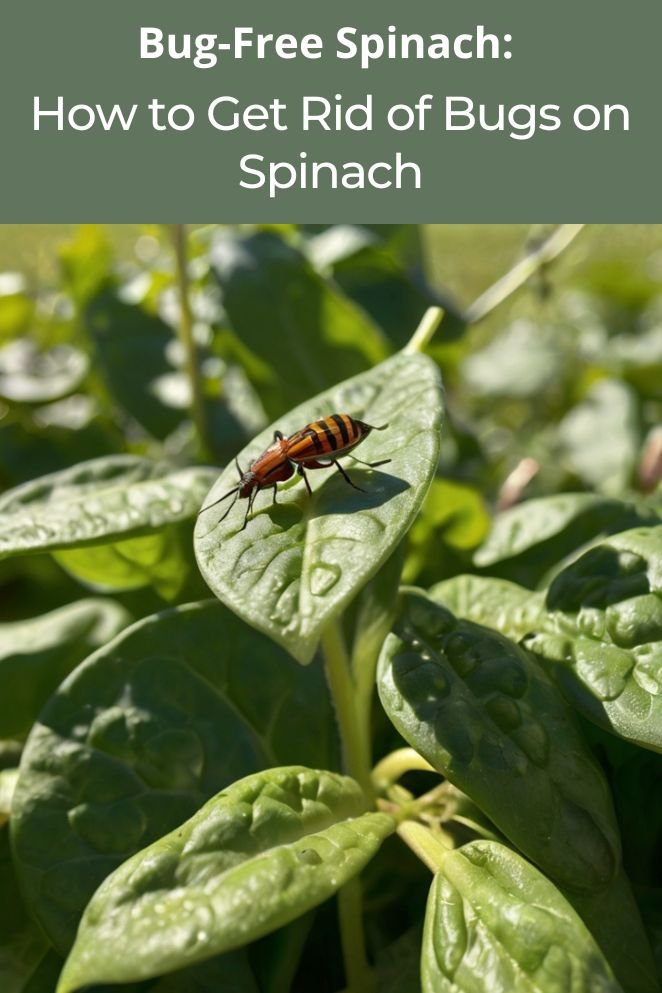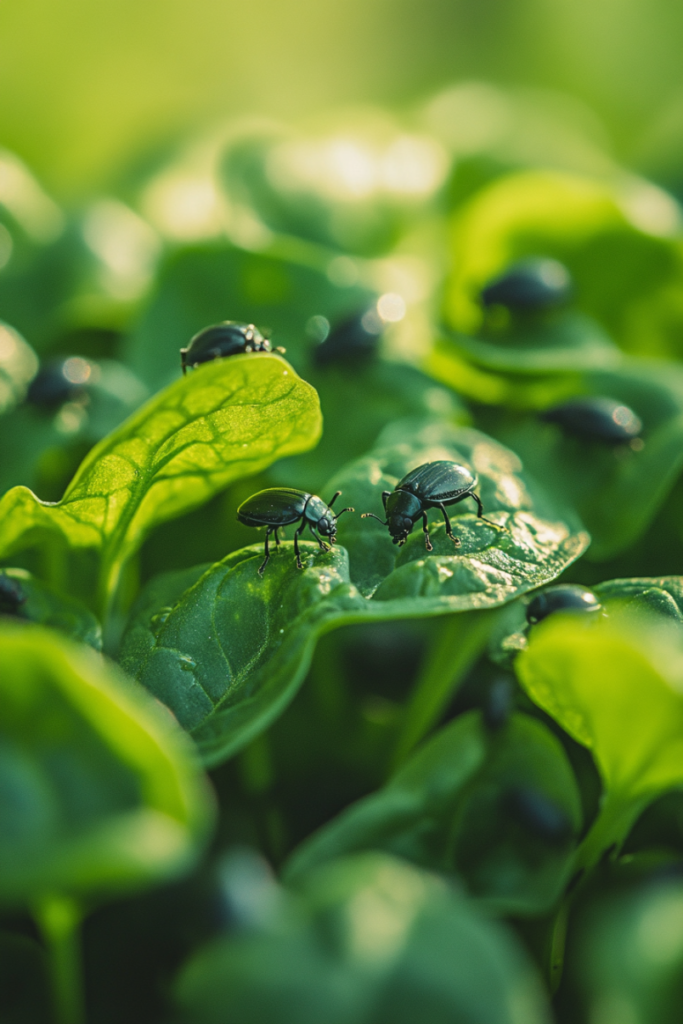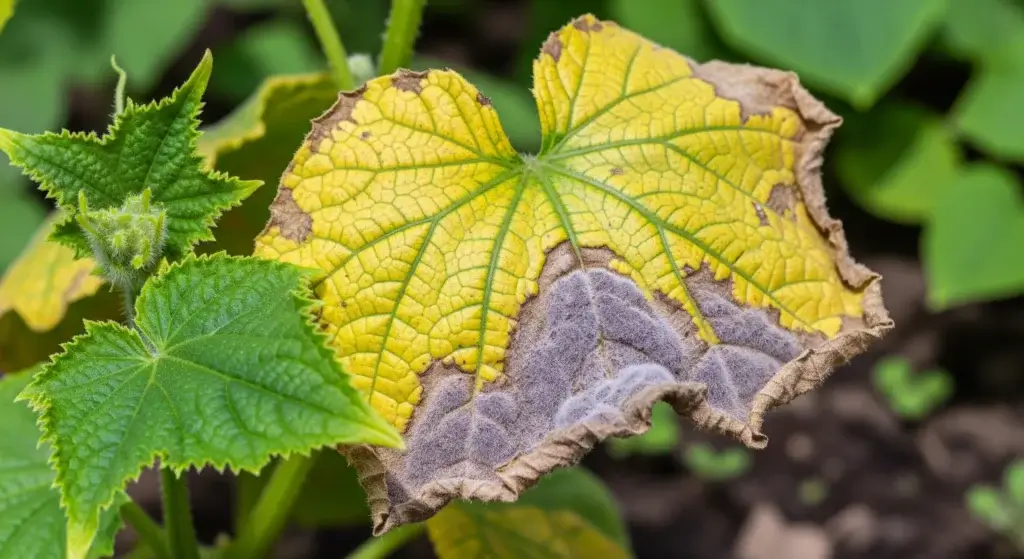
Spinach is a nutrient-rich leafy green that’s a favorite for home gardeners because it’s easy to grow and can be used in many dishes.
However, like all plants, spinach can attract pests that can damage your crop.
Protecting your spinach from these bugs is important for a successful and healthy harvest.
In this guide, we’ll go over the most common pests that affect spinach, how to prevent them, and both natural and chemical ways to keep them under control.
Identifying Common Spinach Pests
Before you can protect your spinach, it’s important to recognize which pests are causing the damage.
Here are the usual suspects:
Aphids
Aphids are tiny, soft-bodied insects that often gather on the undersides of spinach leaves.
They feed on the plant’s sap, which can weaken the spinach, making the leaves curl or turn yellow.
Aphids also spread plant viruses and can multiply quickly, so it’s important to catch them early.
Flea beetles
Flea beetles are small, shiny beetles that hop away when disturbed, much like fleas.
They create tiny, round holes in spinach leaves, leaving a “shotgun” pattern of damage.
If left unchecked, flea beetles can stunt young plants and make mature leaves look unattractive.
Caterpillars
Various types of caterpillars, such as armyworms and cutworms, love to chew large holes in spinach leaves.
These pests are usually active at night and can cause serious damage if not controlled quickly.
Slugs and snails
Slugs and snails are notorious for munching on leafy greens like spinach.
They leave behind irregular holes in the leaves and a slimy trail as they move.
These pests thrive in damp environments and are especially problematic in humid climates.

Prevention Tips
Taking steps to prevent pests from the start can save you a lot of hassle later.
Here are some simple ways to keep your spinach pest-free:
Plant spinach at the right time
Planting spinach in cooler weather can help avoid pests like aphids and flea beetles, which thrive in warmer conditions.
Since spinach is a cool-season crop, it’s best to plant it in early spring or fall. This reduces the chances of a pest infestation.
Practice crop rotation
Changing where you plant spinach each season can help prevent pests from settling in your garden.
Some pests lay eggs in the soil, so if you plant spinach in the same spot year after year, you might face recurring infestations.
Rotate spinach with plants that aren’t targeted by the same pests to disrupt their life cycle.
Use companion planting
Certain plants can naturally repel pests.
For instance, planting onions or garlic near your spinach can keep aphids away, while radishes can act as a “trap crop” for flea beetles, attracting them away from your spinach.
Companion planting is a great, chemical-free way to minimize pest issues.
Keep your garden clean
A clean garden is less inviting to pests.
Remove debris, fallen leaves, and weeds regularly, as these can give pests like slugs and caterpillars a place to hide.
Keeping your garden tidy reduces the chances of pests finding a home in your spinach patch.

Natural Pest Control Methods
If pests manage to invade your spinach plants, don’t worry—there are plenty of natural ways to deal with them without resorting to harsh chemicals.
Here are some effective methods:
Neem oil
Neem oil is a natural insecticide made from the neem tree.
It works by disrupting the life cycle of pests, preventing them from feeding or reproducing.
Simply spray neem oil on your spinach leaves to target pests like aphids, caterpillars, and flea beetles.
It’s safe for most beneficial insects but should be applied carefully.
Insecticidal soap
Insecticidal soap is a non-toxic option that’s great for controlling soft-bodied pests like aphids.
The soap breaks down the outer layer of the pests, causing them to dehydrate and die.
For it to work, you need to apply the soap directly to the pests.
Diatomaceous earth
Diatomaceous earth is a fine powder made from the fossilized remains of tiny algae.
It’s harmless to people and pets, but deadly to soft-bodied pests like slugs and caterpillars.
Sprinkle it around your spinach plants or directly on the leaves. The powder’s sharp particles damage pests, keeping them away.
Row covers
Row covers are lightweight fabrics that act as physical barriers to keep pests from reaching your spinach.
They block flying insects like flea beetles and can also stop crawling pests like caterpillars.
These covers are particularly helpful for gardeners who prefer to avoid using any chemical treatments.
Handpicking pests
For larger pests like caterpillars and slugs, simply picking them off by hand can be effective.
Check your spinach plants regularly, especially in the early morning or late evening when these pests are most active.
Drop them into a bucket of soapy water to make sure they don’t return.

Organic Pest Control Methods
Organic pest control focuses on using natural solutions and biological methods to manage pests without harming the environment.
Here are some effective organic approaches:
Beneficial insects
Introducing helpful insects to your garden is a natural way to control pests.
For example, ladybugs are great for eating aphids, and parasitic wasps can help reduce caterpillar populations.
You can encourage these beneficial insects by planting flowers like marigolds or dill, which help create a balanced ecosystem in your garden.
Companion plants that repel pests
Certain plants can naturally keep pests away.
Planting mint or basil near your spinach can help deter flea beetles and aphids.
Additionally, nasturtiums can act as a “decoy” plant, attracting aphids away from your spinach, keeping your crop safe.
Homemade pest deterrents
You can create simple, effective pest deterrents right at home.
For instance, a mixture of water and crushed garlic can repel aphids, while a solution of water and mild dish soap works well against soft-bodied insects like aphids and mites.
Just be sure to test any homemade sprays on a small part of your plant to ensure they won’t cause harm.

Chemical Pest Control (Last Resort)
While it’s best to stick with natural and organic methods, there may be times when using chemical pesticides is necessary to save your spinach crop.
Here’s how to approach it safely and effectively:
Choosing the right pesticide
If you decide to use a chemical pesticide, make sure to choose one that’s safe for leafy greens like spinach.
Look for a pesticide specifically designed to target the pest you’re dealing with, whether it’s aphids, flea beetles, or other insects.
Safe and effective application
Always carefully follow the instructions on the pesticide label.
It’s best to apply the pesticide in the early morning or late evening when beneficial insects like bees are less active.
After treatment, be sure to wash your spinach thoroughly before eating, especially when using chemical sprays.
Final Thoughts
Managing pests on spinach can be challenging, but with the right prevention and control strategies, you can keep your plants healthy and bug-free.
Whether you choose natural, organic, or chemical methods, staying proactive is key.
By regularly inspecting your plants and using a combination of techniques, you can enjoy a bountiful spinach harvest with minimal pest damage.



